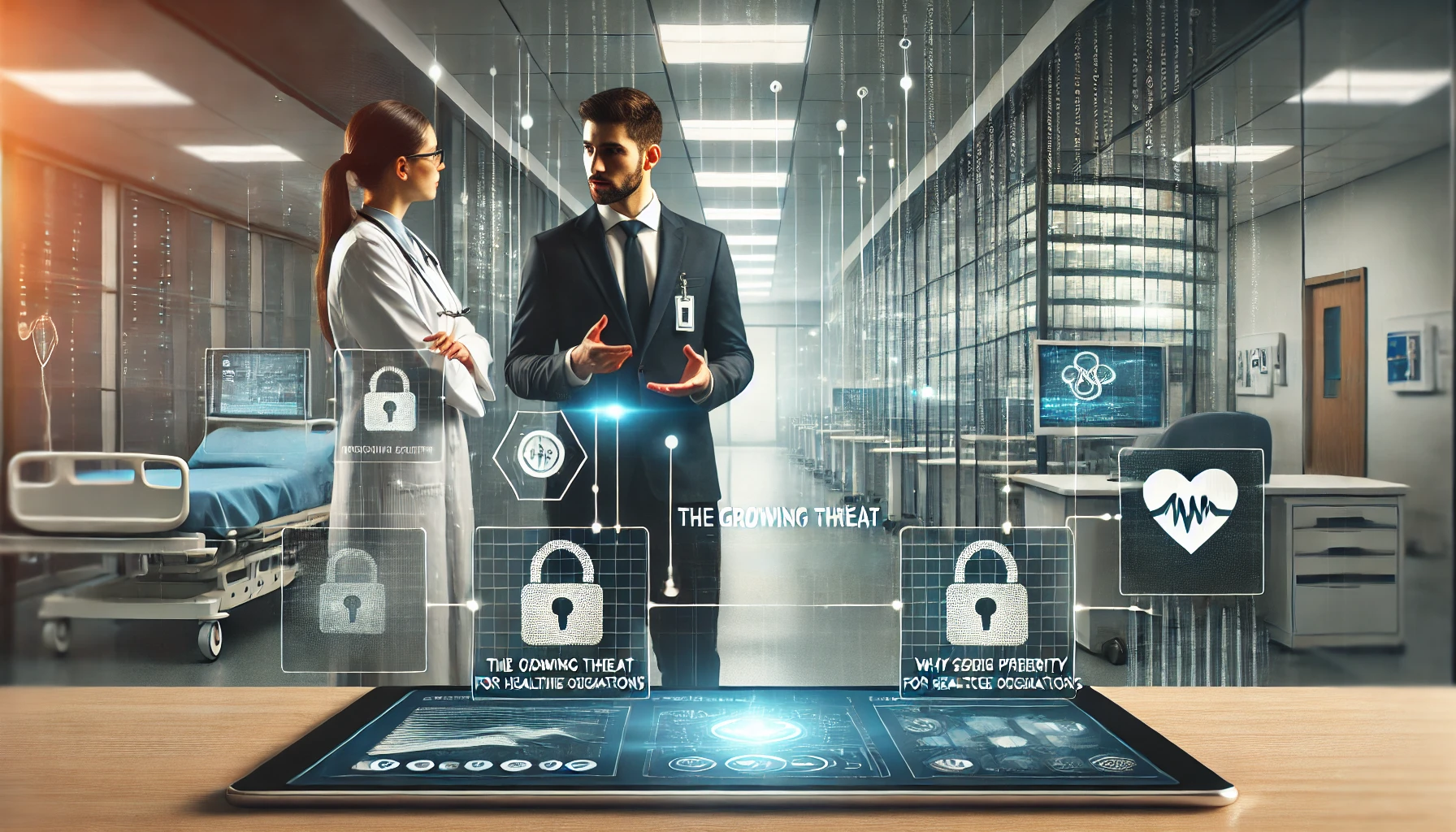
In today’s digital era, cybersecurity has emerged as a critical concern for healthcare organizations. As these institutions adopt advanced technologies and electronic health record systems, they become prime targets for cyberattacks. The sensitive nature of patient data, combined with the complexity of healthcare operations, makes cybersecurity a top priority. The stakes are high: a breach can compromise patient trust, disrupt essential services, and result in significant financial and reputational damage. This article explores the growing cybersecurity threats facing healthcare organizations, the impact of cyberattacks, and strategies to mitigate risks.
The Rising Threat of Cyberattacks in Healthcare
Healthcare organizations have increasingly become attractive targets for cybercriminals. The industry experienced a dramatic surge in attacks during the COVID-19 pandemic as reliance on digital systems grew. In 2023 alone, healthcare breaches accounted for nearly 30% of all reported data breaches across industries. Hospitals, clinics, and insurance providers are especially vulnerable due to the wealth of valuable data they manage—from personal health information (PHI) to financial records.
One of the primary reasons healthcare is a lucrative target is the high value of PHI on the black market. Unlike credit card data, which can be rendered useless after a fraud report, health information is persistent and can be exploited for years. Hackers can use it for identity theft, insurance fraud, and even blackmail. Moreover, the fragmented nature of healthcare systems, often involving multiple vendors and outdated legacy software, creates numerous vulnerabilities for cybercriminals to exploit.
Types of Cybersecurity Threats in Healthcare
Healthcare organizations face a variety of cyber threats, including ransomware attacks, phishing schemes, and insider threats. Understanding these threats is key to building effective defenses.
• Ransomware Attacks: Ransomware remains one of the most devastating cyber threats. Attackers encrypt critical systems and demand payment in exchange for restoring access. In healthcare, these attacks can lead to delayed treatments, canceled procedures, and, in extreme cases, patient harm. A prominent example is the 2021 ransomware attack on Ireland’s Health Service Executive, which disrupted care nationwide for weeks.
• Phishing Schemes: Phishing emails trick employees into revealing sensitive information or downloading malicious software. Cybercriminals often use social engineering tactics to exploit human error, bypassing even the most robust technical safeguards.
• Insider Threats: Not all cybersecurity breaches come from external attackers. Disgruntled employees or contractors with access to sensitive data can intentionally or unintentionally compromise security. For example, a staff member clicking on a malicious link or misusing data can have catastrophic consequences.
• Medical Device Vulnerabilities: The rise of connected medical devices, from insulin pumps to pacemakers, introduces new attack vectors. If compromised, these devices can not only jeopardize patient safety but also serve as entry points for broader network attacks.
• Supply Chain Attacks: Healthcare organizations often rely on third-party vendors for services such as billing, cloud storage, and software. A breach in a vendor’s system can ripple through the healthcare organization’s network, as demonstrated by the 2020 SolarWinds attack.
The Impact of Cyberattacks on Healthcare
The consequences of a cybersecurity breach in healthcare extend far beyond financial loss. The impact can be devastating for both organizations and patients.
• Patient Safety: In healthcare, time is critical. A cyberattack can paralyze systems, delay treatments, and jeopardize patient outcomes. For example, an attack that disrupts access to electronic health records (EHRs) can prevent doctors from accessing vital medical histories.
• Financial Losses: Cyberattacks can result in enormous financial costs, including ransom payments, legal fees, and regulatory fines. Additionally, healthcare organizations must invest in system recovery, forensic investigations, and public relations efforts following a breach. According to a 2023 IBM report, the average cost of a healthcare data breach reached $10.93 million.
• Reputational Damage: Patient trust is the cornerstone of healthcare. A data breach erodes this trust, leading to loss of business and long-term damage to an organization’s reputation. Patients are less likely to engage with a provider they perceive as insecure.
• Regulatory Consequences: Healthcare organizations must comply with stringent regulations, such as the Health Insurance Portability and Accountability Act (HIPAA). A cybersecurity breach can result in hefty fines for non-compliance and trigger audits that disrupt operations.
Why Cybersecurity Must Be a Top Priority
The growing frequency and sophistication of cyberattacks make it imperative for healthcare organizations to prioritize cybersecurity. Beyond protecting data, a strong cybersecurity posture ensures operational continuity and safeguards patient lives. Here are some key reasons why cybersecurity should be a strategic priority:
Increasing Connectivity: The integration of IoT devices, telehealth platforms, and EHR systems has expanded the attack surface, making healthcare networks more vulnerable.
High Stakes: Unlike other industries, cyberattacks in healthcare can have life-or-death consequences. Ensuring system resilience is essential for maintaining patient safety.
Regulatory Scrutiny: Regulatory bodies are placing greater emphasis on cybersecurity compliance. Organizations that fail to meet standards risk severe penalties.
Evolving Threat Landscape: Cybercriminals are constantly developing new tactics, requiring healthcare organizations to stay ahead of emerging threats through proactive measures.
Strategies to Strengthen Cybersecurity in Healthcare
While the challenges are significant, healthcare organizations can adopt several strategies to mitigate cybersecurity risks and build resilient systems.
• Invest in Advanced Technologies: Employing cutting-edge security tools such as intrusion detection systems, endpoint protection, and threat intelligence platforms can help detect and prevent attacks. Artificial intelligence and machine learning can identify anomalies and predict potential threats.
• Implement Multi-Factor Authentication (MFA): MFA adds an extra layer of security by requiring users to verify their identity through multiple means. This simple measure can prevent unauthorized access, even if login credentials are compromised.
• Conduct Regular Training: Human error remains a leading cause of breaches. Ongoing training programs can educate employees about phishing scams, password hygiene, and proper data handling practices.
• Develop an Incident Response Plan: Preparing for the inevitable is critical. A robust incident response plan ensures that organizations can quickly contain and mitigate the damage caused by a cyberattack. Regular drills and simulations can test the effectiveness of the plan.
• Secure Medical Devices: Healthcare organizations must collaborate with device manufacturers to ensure that connected medical devices are secure. Regular software updates and vulnerability assessments are essential.
• Strengthen Vendor Management: Given the risks associated with third-party vendors, organizations should conduct thorough due diligence, require vendors to adhere to security standards, and monitor their activities.
• Encrypt Data: Encryption ensures that even if data is intercepted, it cannot be easily accessed or exploited. Both data at rest and data in transit should be encrypted.
• Adopt Zero Trust Architecture: Zero trust models operate under the assumption that threats may exist both inside and outside the network. By implementing strict access controls and continuously monitoring activity, organizations can minimize risk.
The Role of Leadership in Cybersecurity
Effective cybersecurity requires strong leadership and a culture of accountability. Healthcare executives and boards must prioritize cybersecurity as a core organizational goal, allocating sufficient resources and integrating it into strategic planning. Appointing a Chief Information Security Officer (CISO) and establishing cross-departmental cybersecurity committees can enhance coordination and oversight.
Moreover, fostering a culture of security awareness throughout the organization ensures that every employee, from front-line staff to senior management, understands their role in protecting sensitive data. Cybersecurity should be viewed not as an IT issue but as a shared responsibility across all departments.
As the healthcare industry continues to digitize, the importance of cybersecurity will only grow. Emerging technologies, such as blockchain and quantum computing, hold promise for enhancing security, but they also introduce new challenges. Staying ahead of the curve will require continuous investment, innovation, and collaboration across the healthcare ecosystem.
The growing threat of cyberattacks is a stark reminder of the vulnerabilities inherent in modern healthcare systems. By prioritizing cybersecurity, healthcare organizations can protect patient trust, ensure operational continuity, and fulfill their mission of delivering high-quality care. The time to act is now, as the cost of inaction is simply too great.
